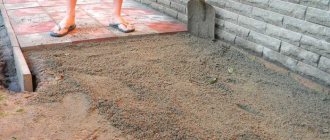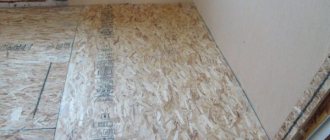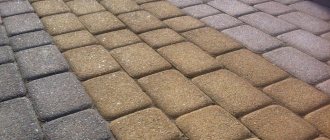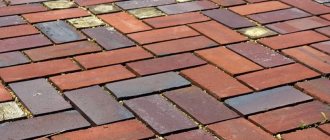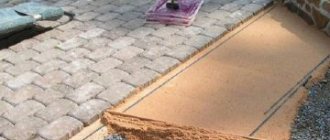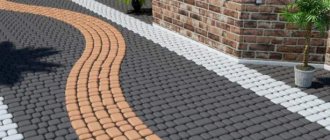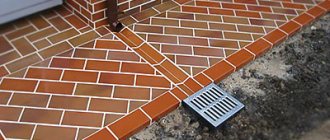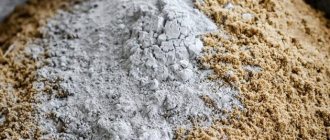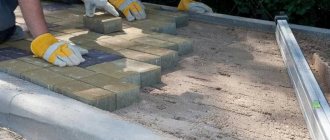A Complete Guide to Laying Paving Slabs on Concrete
Laying paving slabs on a concrete base provides the coating with the highest degree of strength. This method is most often used in areas of high load to ensure reliable adhesion of the paving stones and simplify leveling of the surface. In addition, it allows even beginners to independently improve the territory of their own home, because it is much easier to lay the material when there is a solid base underneath, rather than a moving sand-crushed stone mixture. If the technology is followed and the instructions are strictly followed, the coating laid on concrete will delight the eye with its beautiful appearance for decades.
Basic requirements for tile quality
Basic models of paving slabs must have performance characteristics strictly defined by GOST 17608-91 “Concrete paving slabs”:
- Frost resistance – at least 200 freezing and thawing cycles.
- Water absorption – no more than 5%.
- Abrasion – no more than 0.7 g/cm2.
- Strength – not less than 30 MPa.
If frost resistance directly depends on water absorption (the lower the second, the higher the first), then abrasion and strength are largely determined by the class of concrete and the thickness of the coating.
- Concrete-polymer tiles up to 30 mm thick are used to form sidewalks and pedestrian paths.
- Paving stones from 50 mm are used in places of significant local load; for example, a passenger car can move on such a surface.
- To make it possible to move heavy vehicles, for example, around a site near a large shopping center, tiles with a thickness of 80 mm or more, made of high-strength concrete, are selected.
By the way, if you lay paving stones on a concrete base, then their thickness can be less, even in the case of areas for large vehicles.
Technology for laying granite paving stones
Technology for laying granite paving stones
Granite paving stones have remained one of the most popular types of paving for many centuries. It is used for paving roads, squares, squares and private courtyards. The secret of its popularity lies in the unique quality properties of the material. It is characterized by:
- strength;
- wear resistance;
- durability;
- environmental friendliness;
- aesthetics;
- resistance to external factors.
Granite paving stones from a manufacturer in Samara have an attractive price, which depends on the deposit of raw materials, stone processing technology, purchase volume, and so on. You can find the most advantageous offer according to your own capabilities and needs on the Internet.
Features of laying granite paving stones
In addition to the choice of material, the technology of laying the road surface plays an important role. The professionalism of specialists, the equipment they use and work methods affect the durability and aesthetics of the surface. Paving with granite paving stones requires knowledge of the subtleties and nuances of this process. The cost of the work directly depends on the complexity of the ornament. There are several styling inputs, popular technologies are:
- fan;
- in-line;
- arbitrary.
The variety of shades and textures of granite allows you to embody original patterns and design ideas. Paving granite paving stones is a complex step-by-step process that begins with preparing the base. This stage consists of several points:
- turf extraction;
- soil compaction;
- laying borders;
- filling the surface with sand and crushed stone mixture.
The advantage of working with paving stones is the ability to dismantle them and re-paving them. This is extremely convenient, since pipes and other communication systems are often located under the road surface.
Operation of granite paving stones
Granite paving stones from a manufacturer in Samara are a profitable investment in quality and attractiveness. By purchasing products from a warehouse, you can significantly save time and money. Modern stone processing technologies make it possible to create materials with different external characteristics. Today there are several types of granite paving stones:
- crushed (wild stone);
- sawn;
- split-sawn.
Each option has its own price range. Granite tiles with a natural surface are the most affordable. Also, granite products can be given a special shine, roughness, and anti-slip properties. Laying granite paving stones is a guarantee of reliability, quality, durability and safety. Paving can be done at any time of the year, since granite is not afraid of temperature changes and atmospheric influences. The material is extremely wear-resistant and, under the influence of pressure and vibration, becomes even more beautiful than immediately after installation. Granite paving stones are a reliable and high-quality alternative to asphalt pavement. Professional installation in compliance with all paving technologies will guarantee the durability of the coating.
Where to buy tiles in the Stavropol Territory
You can buy paving slabs in Stavropol and Mikhailovsk at the “Roman Master” TVK. The trade and exhibition complex offers products that are not inferior in quality to foreign analogues. A variety of colors, shades and modifications will please even the most demanding customers. The paving stones are made using European equipment from first-class raw materials, which makes them especially strong, durable, resistant to abrasion, fading and destruction. Local production, quality assurance, huge selection, fast delivery – these are the main advantages of the building material offered by TVK.
We carry out preparatory work for laying the material
Preparation of the base for concrete pouring is carried out in several stages:
- We break up the area. We fence off the covering area with pegs and twine. Be sure to take into account drainage areas.
- We check the markings - the minimum height from the ground to the twine should be 0.4-0.5 meters (this is exactly the depth to which the soil freezes).
- We dig a trench 25 cm and strengthen the edges with formwork to prevent further destruction.
- We fill in the compactor (it can be compacted soil, clay or other material).
- We make a “pillow” of 10-15 centimeters of sand.
- Pour gravel or crushed stone, also 10-15 centimeters, carefully level and compact.
After completing the preparatory work, it is important to allow the “cushion” of sand and crushed stone to settle for 2-3 days. Then you can start pouring the concrete mixture.
Preparing a concrete pillow
After the layers of sand and crushed stone have settled for a couple of days, we fill the trench with concrete. First, we install drainage from pieces of asbestos pipe. The holes will allow excess moisture to be removed in the future. To ensure the strength of the base, reinforcing mesh is used. First, concrete (approximately 5 cm thick) is poured onto the “cushion” of crushed stone, then a mesh is laid, which is filled with another layer of concrete up to 10 cm. After this, the concrete slab is poured. It is better to carry it out continuously for 3-4 hours until the entire trench is completely filled, otherwise there is a possibility of the formation of so-called cold seams, which subsequently lead to destruction of the base. After laying, the concrete is bayoneted to remove air and compact the mixture. After three days, when the concrete base has completely hardened, you can proceed directly to laying the paving slabs.
Technology for laying granite paving stones
Subject to compliance with building codes and strict compliance with technological processes, laying granite will not be difficult and will bring the desired result.
Typically, 3 types of natural stone masonry are used:
“Wild” is a masonry of irregularly shaped stones bound together with cement mortar. For this masonry, fractions of different sizes are used. Typically, the best quality material is used on the front side. However, during the transportation process, a lot of “substandard” material appears, which the craftsmen use from the inside of the fence, calling the technology “wild” rubble masonry;
Timber (traditional) - masonry made of a material of regular shape (trapezoid or parallelogram) with two parallel sides. The front surface can be smooth or “ragged”. The best stone is used for the front side, and the remaining one is used for walling the inside.
You might be interested
Granite slab Stone for alpine slide Granite cladding
Improved plank – masonry made of high-quality natural stone. To do this, select a stone of a rectangular or square shape. This method is used for walling columns and columns. Technology for laying granite paving stones The technology for laying granite paving stones depends on the planned load and density of the soil. Taking this into account, the soil layer is compacted with a vibrating plate or a concrete screed is created. A cushion of crushed stone, about 10 cm thick, is placed on the compacted base. In this case, the fractionation also depends on the expected load. A layer of a mixture of granotsev and cement is applied to the crushed stone layer. With a paving stone thickness of 50 mm, a concrete base is more often used. The seams are spilled with a prancing pattern, and the water goes into the storm drains along the slope. With a paving stone thickness of 100 mm, compacted granite screenings or sand can be used. Water goes into the ground between the seams, so there is no need for storm drains. Grass may grow between the stones. Due to the fact that chipped paving stones have very significant tolerances in linear dimensions, in standard row laying options the seams can be smooth only in one direction. Therefore, you initially need to determine the direction of the seams and rows. Usually, smooth seams are created in the direction of movement. You can find masonry with even seams in all directions, but at the same time the width of the seam increases significantly.
The technology for laying granite paving stones depends on the planned load and soil density. Taking this into account, the soil layer is compacted with a vibrating plate or a concrete screed is created. A cushion of crushed stone, about 10 cm thick, is placed on the compacted base. In this case, the fractionation also depends on the expected load. A layer of a mixture of granotsev and cement is applied to the crushed stone layer. With a paving stone thickness of 50 mm, a concrete base is more often used. The seams are spilled with a prancing pattern, and the water goes into the storm drains along the slope. With a paving stone thickness of 100 mm, compacted granite screenings or sand can be used. Water goes into the ground between the seams, so there is no need for storm drains. Grass may grow between the stones. Due to the fact that chipped paving stones have very significant tolerances in linear dimensions, in standard row laying options the seams can be smooth only in one direction. Therefore, you initially need to determine the direction of the seams and rows. Usually, smooth seams are created in the direction of movement. You can find masonry with even seams in all directions, but at the same time the width of the seam increases significantly.
Main features of masonry on concrete
Despite the fact that the concrete base ensures the durability of the tiled surface, there is one nuance, ignorance of which can cause significant harm to any paving stones. Excess moisture is the main enemy of the coating; when it gets between the tiles when freezing, it tears the material from the inside. Because of this, tiles can fly off in the first winter. Therefore, it is imperative to ensure reliable drainage and drainage of the site. In addition, the process of laying paving slabs on a concrete base will become much easier if:
- Use moist, well-compacted sand (or cement mortar) as a base; it can also be used to fill tile joints.
- Be sure to install curbs - they provide special strength and greater stability to the coating.
- Buy paving stones only from trusted manufacturers
Laying granite paving stones
A real decoration of a modern country landscape at a summer cottage are paths, paths and other areas lined with granite paving stones. Such exterior elements are much more attractive than paths and areas covered with asphalt or plastic and rubber materials. Thanks to the use of granite paving stones, the area around the house, paths and paths become the leading elements of landscape design. This article explains how to properly lay paving stones yourself.
What are granite paving stones?
The term “granite paving stones” refers to a coating made of granite in the form of bars that have approximately the same size and shape. This material is used for paving sidewalks, city streets and squares, garden paths, areas around cottages, as well as areas where city fountains, monuments and other architectural structures are installed. Paving stones are chipped and sawn granite rectangles that have undergone additional processing.
Advantages and disadvantages
Paving paving slabs on concrete has a number of advantages:
- Sustainability. If masonry on sand can sag under the influence of atmospheric phenomena, then this does not threaten the concrete base, since the tiles fixed in this way cannot budge.
- Long service life. Due to the uniform distribution of the load, paving stones laid on concrete are reliably protected from premature destruction.
- Smooth surface. The coating is easily applied to a concrete base, allowing you to customize the most complex designs and various elements.
But this coating also has its drawbacks: Moisture. Since concrete has a fairly strong and dense structure, water cannot penetrate through it into the ground, as happens in the case of paving with sand or crushed stone. If drainage systems are not properly installed, there is a risk of damage to the material - when freezing, the water turns the coating inside out. Therefore, it is better to entrust laying tiles on a concrete base to professionals.
Working moments
A five-centimeter layer of dry mixture and cement with sand is poured onto the concrete surface (ratio 1 to 5). During the work, a slope of the coating is created by 2-4 degrees. To remove moisture from under the paving slabs, place plastic pieces of tubes in a vertical position (take 1 piece per 1 sq. m). When the concrete mixture hardens, the pipes are cut so that they are flush with the screed. Their holes are filled with crushed stone.
Install the paving stones from the edge of the curb. The master places 4 tiles and draws an even horizon along a cord with a level. Often it is necessary to level the products, so they use a rubber mallet, which is used to strike uneven places or pour cement or paving stones under the paving stones. The method is effective because monetary and physical costs are significantly reduced. The advantage is that it can be installed on a paved surface, but the disadvantage is that the dry mixture will have to be carefully compacted.
Professional workers use vibrating plates for compaction, and to arrange a small area it is enough to build a tool from a metal channel and a tube. A layer of cement mortar up to 3 cm thick is also created. The mixture is leveled with a notched trowel. This “wet” technology for laying products involves the initial arrangement of the site with solid tiles. Then pieces of material are cut off and attached to the mortar, but this is done only after the main concrete screed has dried. Excess mixture is removed with a trowel. To ensure an even surface and slope, a level, rule and cord are used.
Despite the different methods of laying paving slabs, the gap between the paving stones is always 5 mm. The resulting seams are sealed with either quartz sand or grout. When finished, the cracks are spilled with water. It is allowed to walk on the facing mounted surface only after 24 hours.
If you attach the material with glue, you will have to set a certain slope. The layer of the building mixture is 5-10 mm, so the required degree of inclination is created at the initial stage of repairing the concrete base or in the process of creating a coating from scratch. The adhesive solution hardens in different ways. Before work, it is advisable to look at the instructions on the package. Experts recommend making the mixture in small portions, then it will not harden so quickly.
As in other types of paving stone installation, the seams are filled with grout or glue. An undeniable advantage is that with this installation method the tiles will adhere firmly to the concrete screed. Some builders use this particular technique for laying products. The disadvantage lies in the difficulty of replacing one element with another without breaking the material. Because of this, the damaged product is often broken and replaced with a new one.
Consumables and tools
If you need to independently paving paving stones on a concrete base, you need to acquire the following materials and working tools:
- Cement.
- Sand.
- Crushed stone.
- Concrete mixer.
- Construction level (50 and 100 cm).
- Angle grinder (Bulgarian).
- Pusher (manual or automatic).
- Pegs for marking.
- Cord or twine.
- Hose.
- Mallet.
- Master OK.
- Rake.
With all these materials and accessories, the process of laying paving stones will become much easier.
Step-by-step installation instructions
Laying paving slabs on concrete is also carried out in several stages:
- Prepare the surface: remove the top layer of soil and compact it well.
- We install formwork for curbs. To do this, you will need a board 40 mm thick, reinforced with stakes every 10 centimeters.
- We prepare the bottom layer of concrete: to protect against the germination of grass and weeds, we place a geogrid on the ground, then one layer of crushed stone. Compact and level.
- We pour concrete. We place reinforcing mesh on the crushed stone, distribute the mixture over the entire surface in a layer of up to 15 cm. We make expansion joints and drainage systems.
- We put up curbs. First, we fill the prepared trenches with crushed stone and concrete, then place the side stone in them.
- Pour in a dry mixture for masonry made of cement and sand up to 10 cm thick. Carefully level it.
- Laying the tiles. The paving stones are placed 1 piece at a time on the masonry layer, away from you. To ensure the best fit, each tile is tapped with a rubber hammer.
We fill the seams and rinse them with low pressure of water until the coating shrinks.
Scope of application and varieties
Tiles are a strong material that can easily withstand the weight of cars moving over it . With its help, the following sites are equipped:
- large areas in the city center where various city events are held;
- parking places for small and large vehicles;
- the area around the offices of sports complexes, supermarkets, educational institutions, airports, train stations and administrative buildings;
- sidewalks and garden paths;
- plots in private courtyards and parks;
- suburban real estate areas.
The scope of application of the material is unlimited, but in private yards it is mainly placed in front of the garage, house, gate and gate. They often create attractive paths in the garden. Paving stones can be:
- hyperpressed;
- vibropressed;
- vibrocast;
- polymer sand.
Paving slabs are made from granite chips, sand concrete, rubber particles, lime and slate. Sometimes the mixture is diluted with basalt chips. Paving stones, which include granite, are in great demand. It is laid in places with heavy load on the surface, for example, in parking lots. The enterprises produce only 3 varieties:
- the chipped type of the product has embossed edges;
- sawn tiles, the edges of which are extremely smooth;
- split-sawn, the upper and lower sides of which have a smooth edge.
The last 2 options are treated with fire, so their surface becomes non-slip. Often, paving stones are chosen in the shape of a square with parameters of 10x10 cm and from 3 to 10 cm in thickness.
Preparing the adhesive composition
When choosing an adhesive for paving paving stones on concrete, you need to pay attention to the following points:
- Glue base: cement or polymer. Cement mixtures are ideal for external and internal work, and their scope of application is practically unlimited. Polymers contain water-soluble polymer resins. They are so strong that they allow you to fix paving slabs even on a vertical surface.
- Frost resistance. Mixtures for external use must withstand a wide range of temperatures and withstand up to 100 freeze-thaw cycles.
Elasticity. The higher the elasticity index, the better the shock-absorbing properties of the adhesive composition. This means that after hardening, it, together with the paving stones, creates a kind of shock-absorbing cushion, due to which the load is transferred to the concrete base.
Laying tiles
Let's take a closer look at laying the tiles themselves on a ready-made concrete base:
- We remove the formwork.
- Pour the sand-cement mixture.
- Lay the tiles, leaving small gaps (approximately 5 mm). The gaps will prevent it from cracking during sudden temperature changes. Be sure to pay attention to ensuring that the distance between the tiles is the same, so the coating will have an aesthetically attractive appearance.
- We start laying from the curb (especially if we are paving a sidewalk or path).
- We level the surface of each tile with a mallet (a special rubber hammer). Check the line with a level.
Use a wide piece of board or a vibrating plate to press down on the surface of the coating so that the tiles fit more accurately.
Seal the tile seams
After the paving stones are laid, we seal the seams between the tiles. As a rule, they are filled with the same mixture from which the cushion was created. This “grout” prevents plants from appearing and also makes it difficult for excess moisture to get under the tiles. But with this method, it is necessary to leave thermal seams (special through gaps) in order to avoid deformation of the coating. The seams can also be filled with sand, but in this case special attention must be paid to draining water, because sand allows moisture to pass through quite well.
DIY technology for laying granite paving stones
The technology for laying granite paving stones, although similar to the technology for laying conventional paving slabs, still has its own characteristics.
It is known that the cost of paving stones is much higher than the price of tiles. The same applies to installation prices - laying granite paving stones costs significantly more. But if you decide to do everything yourself, then our article will help you understand the intricacies of the technology and improve the landscape yourself. Paving with granite paving stones is a process that requires a professional approach and then the result will be durable and, of course, beautiful.
Preparing the base for laying granite paving stones
Any installation work begins with preparing the base. The first thing we must do is remove the plant layer of soil, reducing everything to one plane if possible, if there are humps or depressions. If any unevenness remains, it’s okay - we’ll get rid of them with sand, screenings or crushed stone. It is also very important before starting work to carry out the correct layout taking into account all slopes. For normal water flow, the slope must be at least 5 percent.
So, the bottom layer has been removed or prepared. The next step will depend on what kind of foundation you have. Perhaps the installation will be carried out not on the ground but on a concrete surface, then the next step will be to fill the area with a cement-sand mixture. But we will consider the most complex option using several layers. Our lowest layer will be a sand layer - with its help we get rid of unevenness. The next base layer for granite paving stones will be a layer of crushed stone with a fraction of 20-40. The thickness of the layer should be approximately 10-20 cm. Another layer of crushed stone can be laid on top, but with a fraction of 10-20. We carefully compact each layer. It is advisable that you have a vibrating rammer in your “arsenal”, but if you don’t have one, you will have to work well with a manual rammer.
Do not forget that the paving stones must be secured at the edges. If there are sides that require support with curbs, then it is better to install them in advance, observing all the slopes that we set at the beginning of the layout.
Granite paving stones
After we have covered the area with crushed stone, we fill in the last layer - a cement-sand mixture in a ratio of 1:3, respectively, provided that grade 500 cement is used. This layer does not need to be compacted - it will be compacted by the paving stones themselves during the laying process, you just need to pour add a little more mixture so that when pressing it, the paving stones are at the desired level. To maintain the lines and height, you need to tighten the thread. Granite paving stones must be laid using a metal hammer. Also, for convenience, use a wooden block with which you will tap the paving stones and level it.
After the paving stones are laid, you need to rub the seams with a cement-sand mixture using a brush. Also, if you have a vibrating rammer, you need to walk around the area with it and straighten the paving stones in those places where it is required. Residues must be removed from the area. After cleaning, we water the paving stones using the sprinkling method - this will help fix it faster. This procedure can be done over several days. Finally, two videos that describe the technology of laying granite paving stones.
DIY technology for laying granite paving stones: 2 comments
- Shnurkov29.09.2016 at 14:36
The first photo gave me a great idea for country paths. Thank you!
Precautions during work
When carrying out any construction activities, it is necessary to comply with the prescribed safety measures. Laying paving slabs on concrete in this sense is no exception. Therefore it is important:
- Use a respirator when working with cement.
- Cutting should only be done with special safety glasses.
- When working with concrete, be sure to wear rubber gloves.
- Thoroughly wash tools from mixtures immediately after finishing work.
- Only cut paving stones on hard surfaces.
If you strictly follow these rules, paving on concrete will not cause much trouble.
Preparation stage for laying tiles
The prepared base must be smooth and dense. Then you should start laying paving slabs according to its design. It is necessary to ensure that each part is pressed tightly to the ground and does not “walk” under your hands.
How to properly make a path from paving slabs
To do this, you should use a rubber mallet - you need to press the tile to the ground and knock it down with this tool.
When laying, usually leave a distance of 1–2 mm using crosses. After the entire area has been filled, it is covered with sand. To do this, you should choose pure raw materials, without impurities, organic additives and salts. Use a street mop to wipe down all the gaps between the elements. Using pure material without additives will avoid plant germination.
After all the work carried out, it is necessary to compact the tiles using a vibrating rammer with a rubber base.
A well-laid base and good paving cover guarantee resistance to mechanical, atmospheric, and chemical influences. Such a platform will last for many years.
